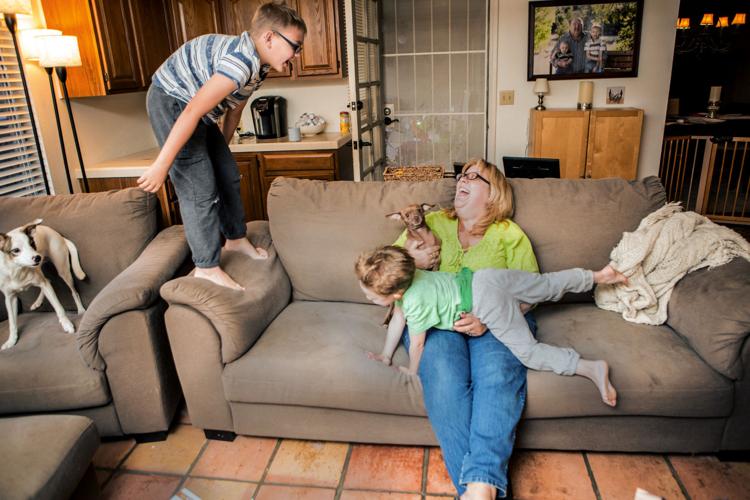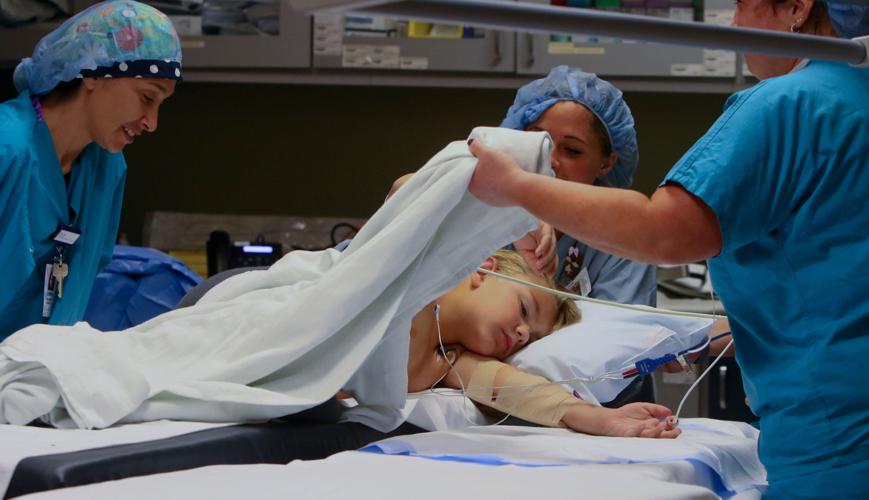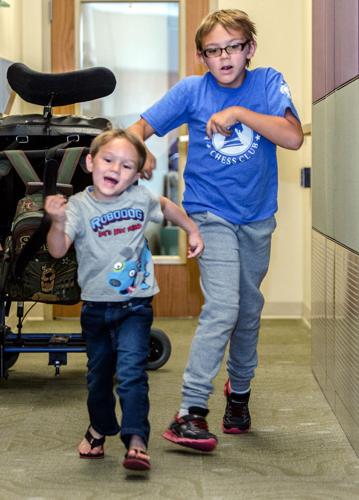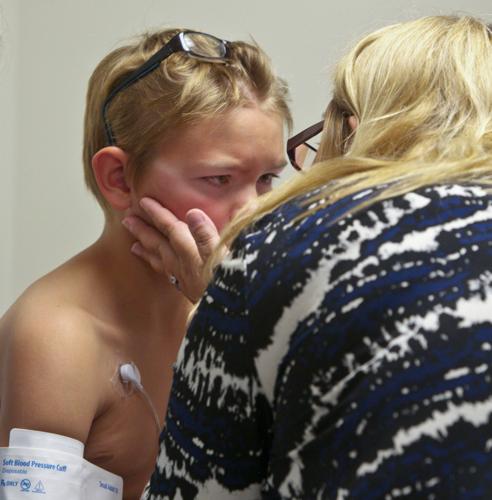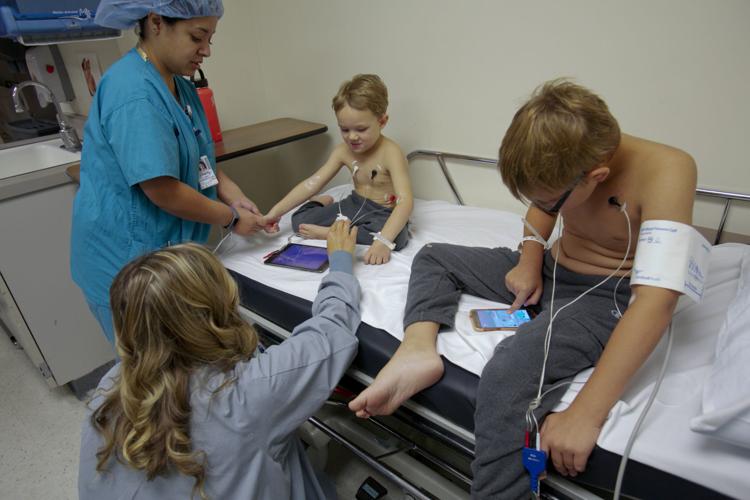Nine-year-old Brayden “Brady” Grabo is dreading the injection he’s going to get in his spine — the third this month.
He reluctantly walks behind his mom and younger brother as they head into Banner-University Medical Center Tucson. He stops and says he doesn’t want to go in.
The treatment could stop the progression of his disease, but Brady is dubious. He tells his mother, Kirsten Cloutier Grabo, that the new drug isn’t going to work. She listens and doesn’t argue, but continues walking.
“Let’s get this done,” she says.
Brady lets out a small groan, but resumes following Kirsten and his 4-year-old brother, Beckett.
His hesitation is understandable. For three years he was hauled to doctor after doctor because he didn’t run or move like other kids. Moreover, he fell a lot.
There were needles. Blood was drawn. There were scans and movement tests at times he would rather have been in school, playing with his friends or jumping on the trampoline.
At the end, at the age of 6, he was diagnosed with a rare progressive, degenerative neuromuscular disease with no cure. His parents were told the disease could eventually leave him unable to walk. And there was no medication to treat it.
That was in June 2014. Three months later, Brady’s father unexpectedly died. And four months after his dad’s death, Brady’s younger brother Beckett would be diagnosed with the same disease.
It was a bad year, to be sure. But Kirsten, now 45, did not have time to dwell. The boys needed to exercise, to travel, to be with other kids. And she needed to juggle it all while continuing to work full time.
As she made sure her kids remained active, she also set about learning about spinal muscular atrophy, or SMA. She began checking the “Cure SMA” website once or more every day, always on the lookout for a new clinical trial or treatment. She joined a Facebook page for parents of children with SMA and began corresponding with an adult in Florida who has the same type 3 SMA as her children.
Life went on with a lot of physical activities to maintain the boys’ muscle strength, but no medications to treat them.
In December, during one of her regular check-ins with the Neuromuscular Multispecialty Clinic at the Children’s Clinics in Tucson, led by neurologist Dr. Katalin Scherer, Kirsten found out that a new drug to treat SMA had been approved.
The drug could reduce and even reverse the progression of SMA. Even their matter-of-fact doctor refers to the way the drug Spinraza works as “almost like magic.”
But getting Spinraza would require trips to the hospital, more needles, and a lot of money — $750,000 per boy for the first 12 months.
The role of Genetics
Kirsten and her husband, John Grabo, had no reason to suspect anything was wrong with Brady when he was born. He was healthy, walked and talked on time, and hit every other milestone.
But by age 3, his running was stiff and slow.
“At first we thought he was not coordinated, or maybe he just wasn’t focusing when he ran,” his grandmother, Carol Grabo, says. “But he fell a lot. He’d crawl even though he could walk. Eventually we all knew it was something.”
SMA affects the part of the nervous system that controls voluntary muscle movement. When muscles aren’t active, they get smaller and atrophy.
The disease is caused by mutations in the SMN1 (survival motor neuron) gene. People who develop SMA must inherit two faulty SMN1 genes, one from each parent. Kirsten and John had no idea until Brady was diagnosed that they were both SMA carriers. Kids like Brady and Beckett, who have parents who are carriers, have a 25 percent chance of being affected by SMA.
Scherer, who is an associate professor of neurology at the University of Arizona, says her clinics in Tucson have about 20 patients — adults and children — with various types of SMA.
There are four types of SMA, with type 1 the most serious and affecting babies in their first few months of life. Those patients do not even sit up and can die from respiratory distress as infants.
Brady and Beckett are type 3, which is a milder but still progressive form of the disease. Doctors are able to type patients based on age of onset and the highest physical milestones achieved.
Losing dad
At the time Brady was diagnosed, John Grabo was working in economic development in Illinois, and the family was planning to join him there. An extroverted businessman with a big laugh who dreamed of being a CEO, he’d previously worked for the Greater Tucson Economic Council and Tech Parks Arizona.
“They were an interesting couple. John was a conservative Republican and Kirsten is a liberal Democrat. Yet they got along really well. They respected each other’s point of view,” says longtime friend and former colleague Bruce Wright, associate vice president of Tech Parks Arizona.
“He did everything with passion. He loved his job. He loved sports and most of all he loved his family. His favorite thing to do was to be at home, grilling a steak, spending time with his family around the pool.”
By midsummer 2014, John had decided he didn’t like living in Illinois and accepted a job as economic development director for the city of Sierra Vista. He was scheduled to begin in September.
He’d been feeling tired as he headed out on his cross-country drive back to Tucson and by the time he arrived, was feeling sicker. A trip to the hospital revealed he had advanced leukemia. He died Sept. 4 at age 52.
“I was stunned. I had been traveling and Kirsten called and told me John was in the hospital and that they thought he had pneumonia,” Wright says. “The next thing I know it’s been diagnosed as leukemia and in a matter of days he passed away.
“I never even got to get a chance to go to the hospital to say hi. Or goodbye.”
Beckett
Four months after John died, Kirsten had Beckett tested for SMA. He was 2 years old at the time, and not showing any symptoms. Still, Kirsten knew there was a chance the test would be positive. The Facebook group for parents of SMA children included several families where more than one child was affected.
“I was hopeful it would be negative,” she says.
The test was positive. Soon Beckett was falling down, too.
As with the other setbacks, Kirsten continued moving forward. She made sure the boys swam regularly and jumped on their trampoline, and she enrolled them in gymnastics classes to keep their muscles in motion. The gymnastics was more fun for the boys than physical therapy.
“I hadn’t heard of SMA. Their story was touching to me,” says Randy Sooter, who owns Old Pueblo Gymnastics and has grown close to the Grabo boys. “They work equally hard or harder than other kids in the class and they don’t use it (SMA) as an excuse.”
Kirsten says Sooter has worked with the boys individually. Sooter and his staff are the reason both boys have stayed walking and strong, she says — part of the “village” that keeps her family going.
Spinraza
On the website Cure SMA (curesma.org) drug pipeline chart that Kirsten checks regularly, Spinraza wasn’t initially one she thought would be approved.
“I’d watch drugs move up on the list, then get shut down or put on hold. Spinraza has changed names three or four times since I’ve been watching,” Kirsten says. “It’s just — you never know.”
All patients with SMA have at least one copy of survival motor neuron gene 2 (SMA2), but it is missing an important component. Spinraza is synthetic genetic material that targets SMA2, causing it to make more complete SMN protein.
“Severely affected babies, from the natural history of this disease, would likely die from complications,” Scherer says. “With this drug they can start kicking their legs and hitting their milestones. That is why I said it’s like magic.”
Since the drug has been primarily studied in infants and younger children, it’s less clear how much motor function will be restored in older children. It could be that the drug stops further degeneration rather than restoring any function they’ve already lost.
Brady can’t ride a bike and his wrists and legs turn in slightly. He prefers pants with elastic waists because buttoning and zipping are difficult. But with Spinraza, that could be as bad as it gets.
By March 31 the Grabo boys were about to get their third “loading dose” of Spinraza. The protocol calls for the first three 5ml doses to be administered at 14-day intervals by an injection in their spine.
Brady, who is a fourth-grade student in the GATE (Gifted and Talented Education) program at Fruchthendler Elementary School, did his science project on Spinraza, so his classmates and teachers know all about it. Before his first injection, they all wrote colorful cards to him, some decorated with strands of DNA.
The March 1 injection did not go as well as hoped and Brady got dehydrated and sick. On the second injection, both boys stayed at the hospital overnight as a precaution. Kirsten slept in their room. It was such a rush the next day that she didn’t have time to shower or change her clothes before heading to work.
On the day of the third dose Brady is anxious. His younger brother doesn’t have the same nervousness, likely because of his age and because he was never misdiagnosed. As Brady worries, Beckett plays video games on a tablet and chats with the staff.
Each dose of Spinraza costs $125,000, and the treatment protocol from drug company Biogen Inc. calls for a fourth dose 30 days after the third. Maintenance doses are then required every four months. They’ll need another dose in the fall, and another in January.
The Grabo boys were the first patients at Scherer’s clinic to get Spinraza, primarily because Kirsten’s employer-sponsored UnitedHealthcare insurance she has as an University of Arizona employee agreed to pay for it. Other patients have slowly been getting approval, but access has been an issue in other areas of the country.
A spokesperson for Massachusetts-based Biogen Inc. said the company’s goal is that the patients who may benefit from Spinraza are able to receive treatment.
Scherer says the cost of the drug is an issue and she is hoping for a wider array of cheaper treatments down the road.
Getting it done
At the hospital for his third dose, Brady tells the nurse he’s going to wait until a pill form of Spinraza is developed.
Banner child life specialist Melissa Shiring steps in and entertains Brady and Beckett with a claylike compound called Model Magic. For a moment, Brady forgets about his anxiety and laughs at the shapes Shiring is creating — a lemon, a bat and a bowling ball.
Kirsten steps out for the needle, and the rest of the procedure goes smoothly for both boys, who get the lumbar injection while under conscious sedation.
“If he didn’t rebound I may have real second thoughts, but he does,” Kirsten says of Brady.
Indeed, when he wakes up from the procedure, Brady’s fine. He even makes it to a birthday party that night. And an April 17 visit with Scherer is encouraging.
“You are not any weaker. You are the same. That is really good,” Scherer tells Brady at the appointment. Brady is all smiles.
On May 1, the fourth dose of Spinraza goes well, too.
As she watches her boys doing gymnastics on May 8, Kirsten is noticing some differences. Her boys’ muscles look bigger. Beckett isn’t using his arms to drag himself up onto higher surfaces — he jumps.
She has come to Old Pueblo Gymnastics from work. Her aunt, Marlyn Stark, brought the boys to gymnastics.
“There’s so much going on all the time for Kirsten and the boys, I am on call when she needs me,” Stark says. “We text a lot.”
Carol Grabo pitches in as a baby sitter when needed. And Kirsten’s parents often visit from Minnesota to help out.
“Those boys are her whole life,” Carol Grabo says. “She had an adjustment after that hard year, but she’s relaxed a little, especially with the Spinraza. She just keeps going and is always planning ahead. She also works very hard to keep John alive for the boys.”
The man with type 3 SMA in Florida that Kirsten corresponds with is still mobile. That, combined with her support system and the Spinraza, have helped a lot.
“I’d love to see them walk across the stage at their graduations, to dance with my boys at their weddings,” Kirsten says.
“There’s so much research going on — we’re right on the cusp of lots of discovery.”
As they show off their new trendy fidget spinner toys on May 9, Brady and Beckett say they think the Spinraza is helping.
“Not a lot, but a little,” Brady says.
“It can make us jump higher and run faster,” Beckett adds before telling a joke about a banana who goes to the doctor because he isn’t peeling well.
Their dad liked to tell jokes, too, the boys say. When asked about their mom, the boys throw out words like funny, amazing and kind. They agree on one sentence that fits best.
“I know she loves us,” Brady says as Beckett nods in agreement.


